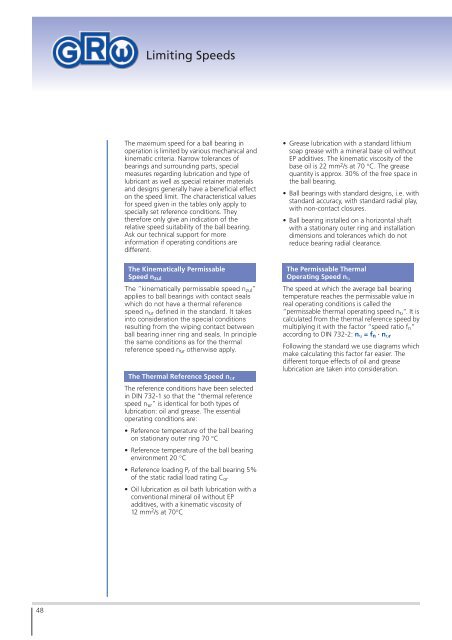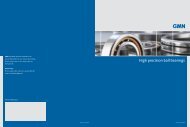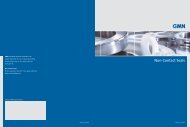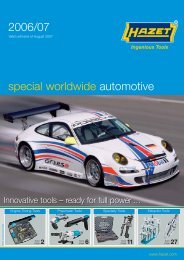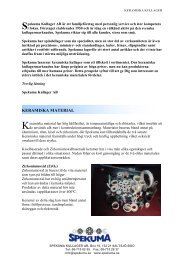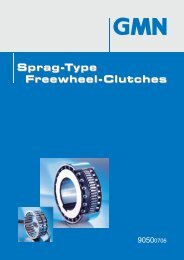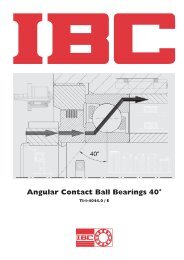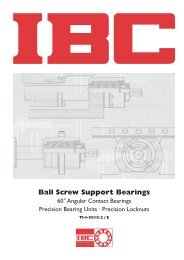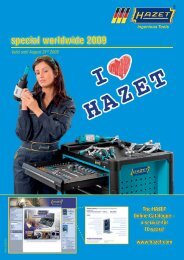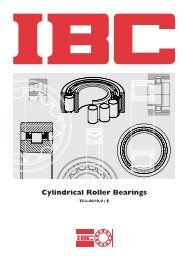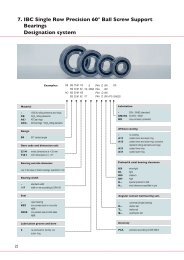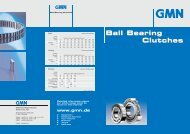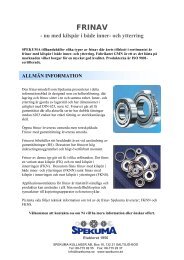You also want an ePaper? Increase the reach of your titles
YUMPU automatically turns print PDFs into web optimized ePapers that Google loves.
Limiting Speeds<br />
The maximum speed for a ball bearing in<br />
operation is limited by various mechanical and<br />
kinematic criteria. Narrow tolerances of<br />
bearings and surrounding parts, special<br />
measures regarding lubrication and type of<br />
lubricant as well as special retainer materials<br />
and designs generally have a beneficial effect<br />
on the speed limit. The characteristical values<br />
for speed given in the tables only apply to<br />
specially set reference conditions. They<br />
therefore only give an indication of the<br />
relative speed suitability of the ball bearing.<br />
Ask our technical support for more<br />
information if operating conditions are<br />
different.<br />
The Kinematically Permissable<br />
Speed n zul<br />
The “kinematically permissable speed n zul ”<br />
applies to ball bearings with contact seals<br />
which do not have a thermal reference<br />
speed n υr defined in the standard. It takes<br />
into consideration the special conditions<br />
resulting from the wiping contact between<br />
ball bearing inner ring and seals. In principle<br />
the same conditions as for the thermal<br />
reference speed n υr otherwise apply.<br />
The Thermal Reference Speed n υr<br />
The reference conditions have been selected<br />
in DIN 732-1 so that the “thermal reference<br />
speed n υr ” is identical for both types of<br />
lubrication: oil and grease. The essential<br />
operating conditions are:<br />
• Reference temperature of the ball bearing<br />
on stationary outer ring 70 °C<br />
• Reference temperature of the ball bearing<br />
environment 20 °C<br />
• Reference loading P r of the ball bearing 5%<br />
of the static radial load rating C or<br />
• Oil lubrication as oil bath lubrication with a<br />
conventional mineral oil without EP<br />
additives, with a kinematic viscosity of<br />
12 mm 2 /s at 70°C<br />
•Grease lubrication with a standard lithium<br />
soap grease with a mineral base oil without<br />
EP additives. The kinematic viscosity of the<br />
base oil is 22 mm 2 /s at 70 °C. The grease<br />
quantity is approx. 30% of the free space in<br />
the ball bearing.<br />
• Ball bearings with standard designs, i.e. with<br />
standard accuracy, with standard radial play,<br />
with non-contact closures.<br />
• Ball bearing installed on a horizontal shaft<br />
with a stationary outer ring and installation<br />
dimensions and tolerances which do not<br />
reduce bearing radial clearance.<br />
The Permissable Thermal<br />
Operating Speed n υ<br />
The speed at which the average ball bearing<br />
temperature reaches the permissable value in<br />
real operating conditions is called the<br />
“permissable thermal operating speed n υ “. It is<br />
calculated from the thermal reference speed by<br />
multiplying it with the factor “speed ratio f n ”<br />
according to DIN 732-2: n υ = f n · n υr<br />
Following the standard we use diagrams which<br />
make calculating this factor far easier. The<br />
different torque effects of oil and grease<br />
lubrication are taken into consideration.<br />
48


